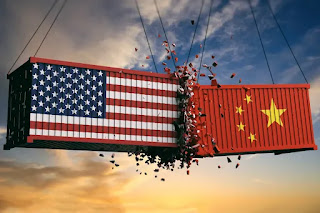The Malaysian semi-conductor industry was slapped with the much awaited Trump tariff of 25%. It should be expected (read September 2024 posting here) but analysts, trade association spokesmen, and government officials been consoling themselves it will not happen.
Earlier this week, stocks of the once booming glove manufacturers caved in and possibly looking at it’s demise following China dumping as a result of tariff imposed by the US.
These are disruptive economic developments beyond any policymaker anticipation. The usual Malaysians' reactions are to find fault with the Ambassador to the US, and pick on Minister’s frequent overseas trips to even Anwar’s stance on Palestine. Blame does not solve problems. Another coup d'etat only worsen matters.
Trump’s actions are to address the longstanding American twin deficit problem. Since the 80s, US faced simultaneous occurrence of large budget and trade deficit. Economic stability and potential negative impact on the US dollar are real concerns.
At the same time, there is strategic consideration to MAGA and defend unipolarity to maintain military and geoglobal political dominance. Another war seemed beyond their affordability.
So is trade war the next and more feasible option?
Twin Deficit
The twin deficit explains for US humongous debt and still accumulating (approaching US$37 trillion and increasing by US$1 trillion every 100 dats) that is financed by issuance of bonds.
In turn, the debt instrument drove interest rates higher, attracted investors to the dollar and further widening of trade deficit. The large deficit also put downward pressure on dollar, causing inflation and reduce competitiveness.
The deficits make the economy vulnerable to external shocks, and slowly US will lose its bargaining power and political dominance.
To address this more than 40 years endemic problem and dedollarisation risk that could end the easy credit and economic hegemony of dollar, Trump is desperately undertaking fiscal adjustment (cut spending via DOGE), change trade policy (encourage exports, reduce imports using tariff) and eventually need to do structural reform to raise productivity, invest in infrastructure.
Costly military adventure
As the most powerful nation in the world and sole superpower during the unipolar phase, economic solution need to take account military and geopolitical strategic considerations.
Coming out of the Russia-Ukraine war and Israel’s Gaza genocide, US has stretched itself by at least US$174 billion and US$23 billion, respectively.
There are also the economic fallout and various long term implication to global trade, market instability, rising oil prices, increased national debt, lost economic opportunities, and shifting global alliances.
The US government justified it as national security interest and geopolitical strategy, but the economic costs are growing, with potential long-term consequences for taxpayers, inflation, and global economic positioning.
Military war vs trade war
Trump the businessmen may have opted for trade war over military approach to preserve their dominance upon looking into a cost benefit analysis between a Military War and Trade War. The decision to choose between military or trade war involves significant trade-offs.
Military war cost billions of dollar for direct military spending, and long term fiscal impact on national debt, decreased investment in public services and inflation. It comes with human cost for loss of life, and veteran care expenditure.
There is the geopolitical risk of military conflict escalate into broader regional or even global wars, leading to unpredictable consequences, and global condemnation, potentially damaging diplomatic ties and economic partnerships.
Goes without saying is the economic disruption from market volatility, sanctions and isolation.
Trade war lead to economic disruptions too. Imposition of tariff raise cost of imported goods, which in turn impact American consumers by increasing prices on everyday items. Established supply chains are disrupted, leading to inefficiencies and delays in production.
Countries subject to US tariffs may retaliate with their own tariffs, harming American businesses that rely on exports. Prolonged trade tensions weaken US ties with economic allies, as countries seek alternative markets or even move away from the US dollar in global trade.
Economic sanctions or tariffs sour relationships with key international partners, leading to political isolation. Countries may seek alternatives to U.S.-led financial institutions, diminishing U.S. influence.
On the other hand, tariffs provide protection to domestic industries that face competition from lower-cost foreign goods. By encouraging domestic production, it could theoretically lead to job creation in sectors previously affected by cheap imports.
And Trump is already doing it, the threat of tariffs or trade barriers allows the US to use economic leverage to negotiate better trade deals, such as the USMCA (United States-Mexico-Canada Agreement), which replaced NAFTA.
Trade could shift global supply chains to benefit US manufacturers and reduce reliance on foreign imports.
Trade war over millitary war
Military war provides immediate strategic influence and secure vital resources or geopolitical dominance, but the human, financial, and long-term economic costs are immense. It severely destabilize global markets, diminish global leadership, and strain diplomatic relations.
While trade war are less destructive in terms of human life and immediate geopolitical instability, but carry significant economic costs in the form of inflation, supply chain disruption, and retaliatory measures.
The primary advantage is the potential for long-term economic rebalancing and the ability to protect domestic industries.
Trump may have opted for the less destructive path with the potential for long-term gains in terms of economic rebalancing and industrial growth and generally more sustainable to avoid loss of life and broader economic devastation of military wars.
It is expected of Trump to target countries with significant trade surpluses with the US for tariffs. (Take note Malaysia.) His administration laid out an "America First Trade Policy," which includes imposing global "supplemental tariffs" to counter trade deficits.
The countries most at risk include China, Mexico, Canada, the European Union (EU), India, and BRICS nations (Brazil, Russia, India, China, South Africa). Trump has already announced a 25% tariff on imports from Mexico and Canada starting February 1. He has also threatened a 100% tariff on BRICS nations if they attempt to move away from the U.S. dollar in global trade.
Will he succeed?
China
China has responded swiftly and strategically to implement both direct and indirect countermeasures. They imposed tariffs of 15% on U.S. energy imports and 10% on crude oil, agricultural machinery, and large vehicles. Restricted exports imposed on materials crucial for defense, electronics, and semiconductor industries.
Chinese authorities launched investigations into U.S. tech giants like Google for alleged antitrust violations and companies like owner of Calvin Klein added to China’s "Unreliable Entity List," limiting their operations within the country. Formal complaint made to the World Trade Organization (WTO) for violating international trade rules.
In the long term, China will deepen ties and strengthen trade with other countries such BRICS nations and ASEAN partners to reduce reliance on US. Export restrictions on critical minerals positions China as a gatekeeper of key materials, pressuring the U.S. to seek alternative sources at higher costs.
While China's response is firm, it has not fully escalated the trade conflict. Beijing is leaving room for negotiations and merely signaling its ability to retaliate. If tensions escalate, China could further limit exports, or increase regulatory scrutiny, or impose broader sanctions on American businesses. Tik Tok ban has been extended again.
Canada and Mexico
Canada made retaliatory moves against Trump's 25% tariff threat and it could have significant economic impacts on the U.S.
It is the largest energy supplier to the U.S. (60% of American crude oil imports, 98% of natural gas imports, and a significant electricity and uranium imports). If Canada decides to cut or restrict energy exports, it could lead to higher energy costs to the U.S. and disrupt supply chains of industries relying on Canadian energy.
Tariffs could reduce U.S. GDP by around 1.6% (roughly $467 billion), while Canada's GDP could shrink by 2.6% ($78 billion). However, it would raise costs for American businesses, make their products less competitive internationally, and push up prices for consumers, exacerbating inflation concerns.
A large share of North American trade involves integrated supply chains, particularly in industries like autos, mining, and pharmaceuticals. If tariff imposed every time a product crosses the border, industries with cross-border production could see higher costs, production slowdowns, and job losses to both sides.
American businesses rely on Canadian imports for raw materials and components. Increased costs due to tariffs would be passed on to U.S. consumers, leading to higher prices on goods ranging from cars to pharmaceuticals.
While Mexico President Claudia Sheinbaum has expressed strong rejection against White House’s claims that Mexico collaborates with criminal organizations.
She is preparing retaliatory measures to tariffs on US imports, including tariffs and other economic actions, though specific targets have not been fully detailed. Mexico's response remain limited to push back against claims and to protect its economy from potential disruptions caused by the U.S. tariffs.
Tariffs undermine the USMCA and a signal U.S. trade agreements are not reliable. It could push Canada and Mexico to deepen trade relationships with other partners, including China, ultimately reducing U.S. economic influence in North America.
European Union
Trump mentioned intention to imposing tariff on EU products and complained of EU blocking American products. The EU’s response is a dual approach: prioritising negotiations while preparing firm retaliatory measures if necessary.
European Commission President Ursula von der Leyen called the proposed tariffs "unjustified". The EU trade chief, Maroš Šefčovič, has already engaged in talks with Trump's trade and economic officials to seek a resolution before any tariffs take effect.
Despite emphasizing diplomacy, it was made clear that EU will not hesitate to impose countermeasures if the U.S. proceeds with tariffs. They have a history of targeting politically symbolic American products in response to Trump's tariffs in 2018.
EU could leverage its regulatory power to impose stricter digital taxes or data-sharing requirements on American companies like Meta and X (formerly Twitter), sectors where the U.S. economy is highly exposed.
Given that the US is a major exporter of services, EU could impose restrictions on consulting, finance, and intellectual property rights to counterbalance trade tensions.
A recently developed Anti-Coercion instrument is a quick retaliatory action tool against economic blackmail, allowing the bloc to impose tariffs, quotas, or exclude U.S. companies from public contracts in Europe.
There are political divisions within the EU's response. In the light of the increasingly coercive Trump policies, EU could unite. They have traditional trade countermeasures and new economic tools that could make retaliation more impactful than in previous trade disputes.
Malaysia?
The coming months will likely determine whether Trump tariff threat is a negotiation ploy or for real, and whether it is a controlled dispute or spirals into a full-scale trade war.
Trump's latest tariff threats against both allies and competitors serve to elevate his domestic appeal, leverage trade negotiation, short-term relief for industries such as steel and aluminum, relocate supply chain back, and pressure on China and BRICS.
If his bluff is called, he face the risk of the potential economic fallout from higher consumer prices & inflation, retaliatory tariffs & trade wars, global economic instability, strained relations with allies, and widespread decoupling from the US economy.
Short-term political and industrial gains come with the long-term risks of rising consumer prices, trade conflicts, and weakened global partnerships outweigh the benefits. If allies and competitors respond by deepening trade alliances outside of the US, American businesses would be disadvantages in global trade.
These countries have the leverage to respond to Trump. For Malaysia, 40% of overall export and 62.8% of export to US comes from Electrical and Electronics sector.
What bargaining power does Malaysia have over the US to negotiate and maintain its path as the next chip giant when Anwar’s call with the straight talking Trump finally comes through?










No comments:
Post a Comment